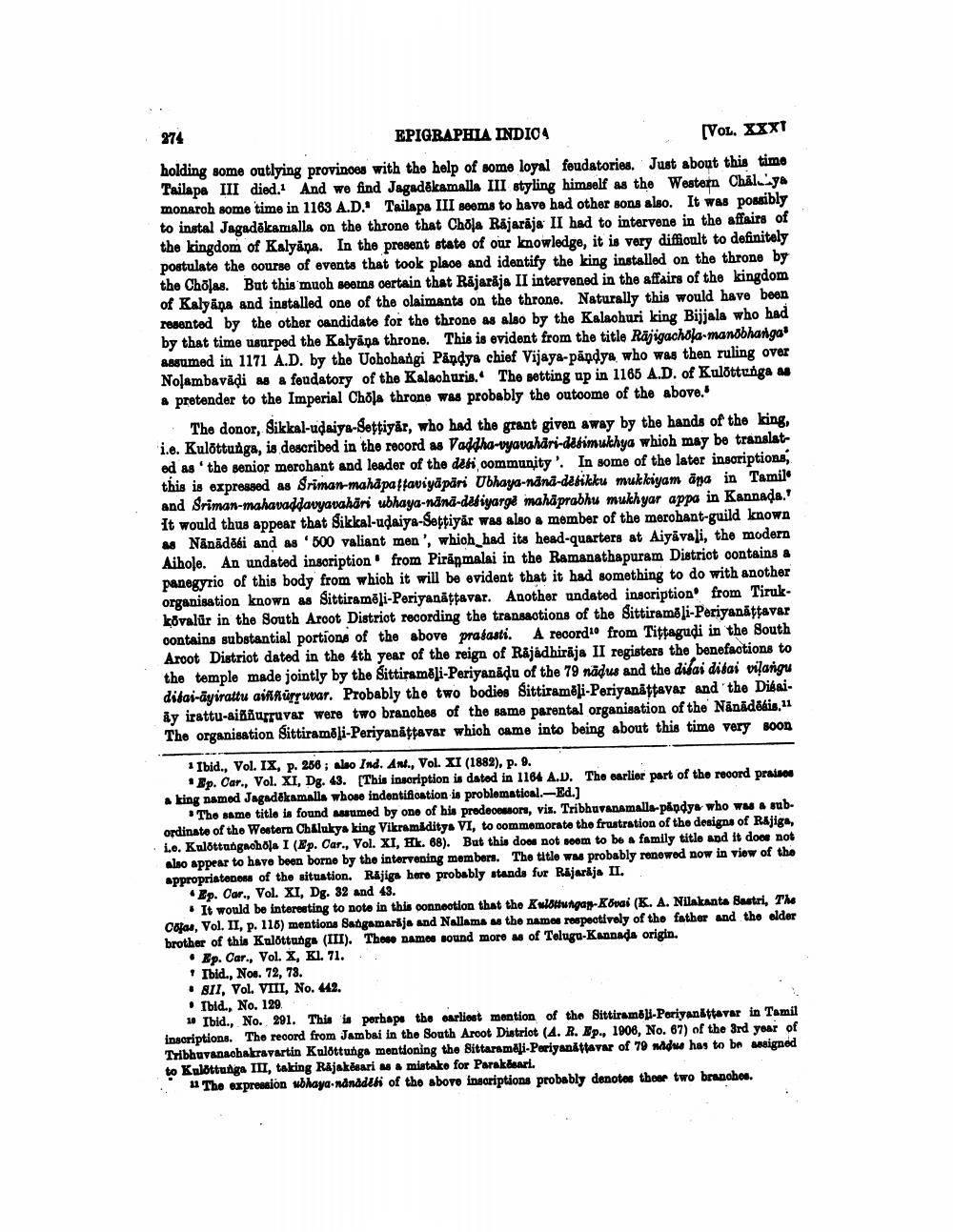________________
EPIGRAPHIA INDICA
(VoL. XXXI holding some outlying provinces with the help of some loyal feudatories. Just about this timo Tailapa III died. And we find Jagadēkamalla III styling himself as the Western Chale.ya monarch some time in 1163 A.D. Tailapa III seems to have had other sons also. It was possibly to instal Jagadēkamalla on the throne that Chola Rajaraja II had to intervene in the affairs of the kingdom of Kalyana. In the present state of our knowledge, it is very diffioult to definitely postulate the course of events that took place and identify the king installed on the throne by the Cholas. But this much sons certain that Rajaraja II intervened in the affairs of the kingdom of Kalyana and installed one of the olaimants on the throne. Naturally this would have been resented by the other candidate for the throne as also by the Kalaohuri king Bijjala who had by that time usurped the Kalyana throne. This is evident from the title Rājigachola-manobhanga assumed in 1171 A.D. by the Uobohangi Pandya chief Vijaya-pāņdya who was then ruling over Nolambavadi as a feudatory of the Kalachuris. The setting up in 1165 A.D. of Kulottunga as a pretender to the Imperial Chola throne was probably the outcome of the above.
The donor, dikkal-udaiya-Settiyår, who had the grant given away by the hands of the king, i.e. Kulottunga, is described in the record as Vaddha-vyavahari-dasimukhya which may be translated as 'the senior merchant and leader of the desi community'. In some of the later inscriptions this is oxpressed as Sriman-mahapaffaviyapäri Ubhaya-nand-delikku mukkiyam ana in Tamil and Sriman-mahavaddavyavahari ubhaya-nand-debiyarge mahaprabhu mukhyar appa in Kannada.' It would thus appear that Sikkal-udaiya-Settiyar was also a member of the merobant-guild known M Nånadski and as 500 valiant men', which had its head-quarters at Aiyavali, the modern Aihole. An undated insoription from Piräpmalai in the Ramanathapuram District contains a panegyrio of this body from which it will be evident that it had something to do with another organisation known as Sittiramēji-Periyanattavar. Another undated inscription from Tirukkovalür in the South Aroot Distriot recording the transactions of the Sittiramõli-Periyanāttavar oontains substantial portions of the above prasasti. A recordio from Tiţtagudi in the South Aroot District dated in the 4th year of the reign of Rajadhiraja II registers the benefactions to the temple made jointly by the Sittiramēji-Periyanādu of the 79 nādus and the disai dibai vilangu didas-āyirattu aiffurruvar. Probably the two bodies Sittiramēji-Periyanāţtavar and the DisaiAy irattu-aißñurruvar were two branches of the same parental organisation of the Nānādesis. 11 The organisation Sittiramoli-Periyanattavar which came into being about this time very soon
* Ibid., Vol. IX, p. 258 ; lao Ind. Ant., Vol. XI (1882), p. 9.
Ep. Car., Vol. XI, Dg. 43. [This inscription is dated in 1164 A.D. The earlier part of the record praises aking named Jagadēkamalls whose indentification is problematioal.--Ed.)
• The same title is found assumed by one of his predecessors, vis. Tribhuvanamalla-påndys who was a subordinate of the Western Chilukya king Vikramadity, VI, to commemorate the frustration of the designs of Rajiga, Lo. Kulottungachola I (Ep. Car., Vol. XI, Hk. 68). But this does not soom to be a family title and it does not also appear to have been borne by the intervening members. The title was probably renewed now in view of the appropriateness of the situation. Räjiga høre probably standa fur Rajaraja II.
Ep. Oar., Vol. XI, Dg. 32 and 43.
. It would be interesting to note in this connootion that the Kulttungar-Kovai (K. A. Nilakanta Sastri, The cofos, Vol. II, p. 116) mentions Sangamarija and Nallams as the name respectively of the father and the elder brother of this Kulottunga (III). The names sound more as of Telugu-Kannada origin.
• Ep. Car., Vol. X, Kl. 71... * Ibid., Nos. 72, 78. • 811, Vol. VIII, No. 412. • Ibid., No. 129
# Ibid., No. 291. This is perhaps the earliest mention of the Sittiramai-Poriyanittavar in Tamil inscriptions. The record from Jambai in the South Aroot District (A. R. Ep., 1906, No. 67) of the 3rd year of Tribhuvanachakravartin Kulottunga mentioning the Sittaramāļi-Periyanittavat of 79 wide has to be assigned to Kulottunga III, taking Rajakesari as a mistako for Parakboari.
u The expression wbhaya-nanadili of the above inscriptions probably denotes theer two branchen.




